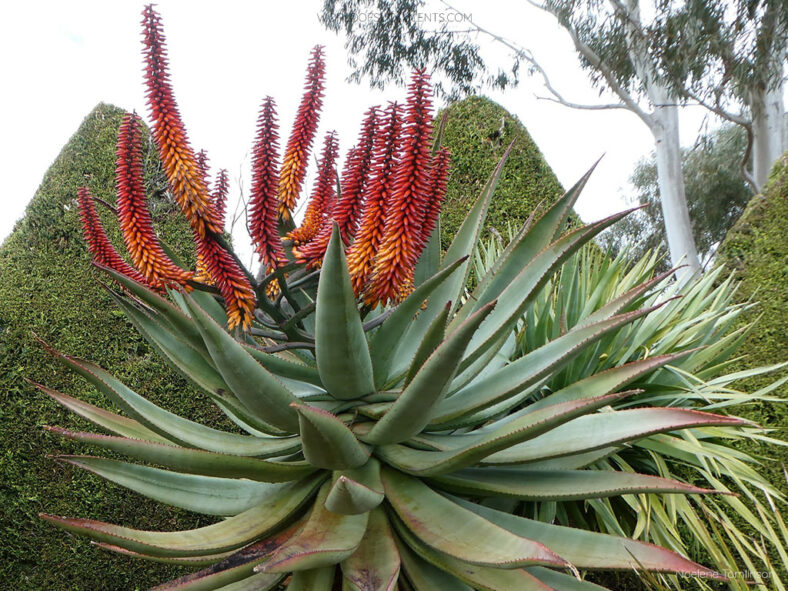Aloe is a genus of over 500 species of succulent plants in the family Asphodelaceae. They are native to tropical and southern Africa, Madagascar, Jordan, the Arabian Peninsula, and various Indian Ocean islands.
Most species are stemless and have a rosette of large, thick, fleshy leaves. Other species may have a branched or unbranched stem from which the fleshy leaves arise. Some Aloes are tall, single-stemmed or branched trees. The leaves vary in color from grey to bright green. They are sometimes striped or mottled. Flowers are tubular, yellow, orange, pink, or red, and are grouped in candle-like or cone-shaped inflorescences that can be branched or simple.
The generic name "Aloe" derives from the Greek "alsos," the Arabic "alloeh," or the Hebrew "allal," all meaning "bitter," and refers to the bitter sap of the leaves.
Aloe plants are among the longest-recorded herbal medicines in human history. They are also among the most widely used plants for traditional medicinal purposes worldwide. Aloe vera, Aloe arborescens, and Aloe ferox are the best-known and most commonly used for their therapeutic properties.

Growing Conditions for Aloe
Aloes are frequently grown as ornamental plants both in pots and in gardens.
Light
When growing Aloe plants indoors, place them near a window that gets plenty of bright, indirect light. To keep your Aloes looking green, avoid exposing them to direct sunlight, as this can cause the leaves to brown. Rotate the pots once or twice a week so that all sides of the plants receive equal lighting. Rotating your Aloe also helps balance out the plant's look, as leaves tend to grow toward the sunlight.
Outdoors provide light shade, especially during the hottest parts of the day. A covered patio or porch is an excellent spot for growing Aloe.
Soil
Plant Aloes in a well-drained soil mix specially formulated for succulents, or make your own. Drainage is essential because too much moisture around roots can cause root rot.
Temperature
Aloes grow best at temperatures between 50°F and 85°F (10°C and 30°C). When temperatures drop below 50°F (10°C), it is time to bring your plants back inside. Maintain a room temperature above 60°F (15°C) and do not expose the plants to temperatures below freezing. Some Aloes are cold-hardy down to USDA hardiness zone 10a, with a minimum temperature of 30°F (-1.1°C). Once the threat of frost has passed, move them back outside in the spring.
Pot Size
Plant your Aloe in a pot containing at least one drainage hole, 2 to 3 inches (5 to 7.5 cm) larger in diameter than the plant's base.
General Care for Aloe
Aloes can live long and thrive with very little care. These plants are great for beginners.
Watering
These succulents need regular watering but are very tolerant of short periods of drought. Water deeply, but only when the soil is dry. Cut back on watering during the winter months. Overwatering is the leading cause of Aloe plant death. Do not let water stand in the rosettes.
Fertilizing
Aloes generally do not require fertilizer, but may benefit from the extra nutrients. Feed with a fertilizer for cacti and other succulents only in spring and summer, following the label directions.
Repotting
These plants are not particularly fast-growing and will only rarely need repotting. Repot them in the spring in a container a few inches larger in diameter every few years to prevent rootbound roots. You can check whether your Aloes are outgrowing their pots by carefully lifting the containers and inspecting the drainage holes. When roots are growing out of the drainage hole, it is time to repot.
Pruning
Removing damaged or excess parts can promote the health and growth of your Aloe. Wait until spring arrives to prune it. Wear gloves whenever you work with Aloe. Some species produce sap that can irritate the skin.
How to Propagate Aloe
Aloes can be propagated by offsets, cuttings, or seeds from a mature plant.
Offsets
The small plants that grow at the base of the plant are known as offsets, offshoots, plantlets, pups, suckers, or babies. You can remove offsets from the mother plant with a sharp knife in late spring or early summer. Plant them in well-drained soil.
Cuttings
Cuttings are a popular way of propagating tree- and shrub-like Aloes. Stem cuttings should be allowed to dry in the shade for a few days or a week before placing them in potting soil.
Seeds
Propagating Aloe from seed is relatively easy. For best results, sow seeds during the warm months. Germination usually begins within 1 week of sowing. Transplant the seedlings once three true leaves have formed, generally after about a year.
Pests and Diseases of Aloe
Aloes are susceptible to mealybugs, scale, and various forms of rot, usually caused by overwatering and inadequate drainage.
Toxicity of Aloe
Not all Aloes have medicinal properties. Some contain poisonous leaf sap, such as Aloe ballyi, Aloe elata, and Aloe ruspoliana, which are used for arrow poison. Humans and animals generally avoid these species.
Links
- Back to genus Aloe
- Succupedia: Browse succulents by Scientific Name, Common Name, Genus, Family, USDA Hardiness Zone, Origin, or cacti by Genus